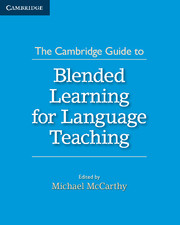Chapter 5 - Blended Teaching and the Changing Role of the Language Teacher: The Need for a Review of Teacher Professional Development
Published online by Cambridge University Press: 22 September 2021
Summary
INTRODUCTION
It is widely accepted that the role of the online language teacher is different to that of the classroom teacher (Baumann et al., 2008 ; Murphy et al., 2011 ; Comas-Quinn et al., 2012). With language teaching moving increasingly toward blended modes of delivery, incorporating online teaching and learning inevitably changes the function of the so-called traditional classroom and its place in the educational system (Moore and Kearsley, 2011). The new elements added to the mix may be tools (instructional, conferencing or social media, for example), activities (telecollaboration, forum discussions) or approaches (flipped classroom, open pedagogy, student-generated content). In this context, teachers need to understand how to perform their roles, not just online, but in relation to each of the elements of the new blended learning (BL) environment.
As technological innovation speeds up, the number and variety of tools is ever-increasing and rapidly changing, so a key challenge for teachers, and a fundamental aim of professional development, has to be understanding how to harness the various tools and modes of teaching to deliver the learning outcomes and meet the learners’ needs. Additionally, teachers have to be made aware that a blended teaching approach, being multimodal (including a combination of media, visual, audio and textual, both online and face-to-face), will require them to engage with learners and peers in a variety of ways, some of which will be new and, at least initially, more demanding (Gallardo et al., 2011 : 219).
Professional development cannot just focus on the technical aspect of mastering tools and skills, but needs to place more emphasis on the pedagogical aspect of understanding what these new technologies enable us to do and how we can effectively apply them to teaching and learning. This distinction between technical and pedagogical knowledge and skills (Hubbard and Levy, 2006), at the core of much professional development for online language learning, still falls short of accounting for the transformational impact that learning to teach within a BL context can have on teachers. Wang, Chen and Levy (2010) recommend a more ‘holistic approach’, that is, one that looks not just at the teacher but at the whole person, taking into consideration the cognitive and the affective, the personal and the professional. This approach should place particular emphasis on identity formation and personal development if training and professional development are to support teachers adequately in their transition to becoming online language teachers, able to deliver the appropriate blend of online and traditional teaching.
- Type
- Chapter
- Information
- Publisher: Cambridge University PressPrint publication year: 2015



